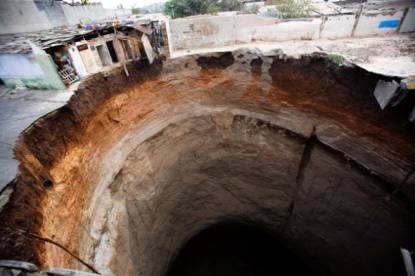
Sink Holes – More Evidence of Cause and Effect?
UPDATES:
Major 7.0-magnitude earthquake hits Papua New Guinea
PORT MORESBY — A major 7.0-magnitude earthquake struck a remote mountainous region of the Pacific nation of Papua New Guinea on Thursday, seismologists said, causing panic but no initial damage or injuries...
Papua New Guinea, which is mired in poverty despite rich mineral deposits, sits on the so-called "Pacific Ring of Fire", a hotspot for seismic activity due to friction between tectonic plates...
Mining in Papua New Guinea is an important source for the Papua New Guinea economy.
History
Up until 1970, there was little mineral extraction in Papua New Guinea, but since the 1970s mineral extraction has dominated the national economy.[1]
With the exception of the Ok Tedi Mine (copper-gold) almost all of the mining in PNG has been gold mining. The two largest gold mines are the Porgera (Enga Province) and Lihir (New Ireland Province) mines. In 2009, the Hidden Valley gold and silver mine (Morobe Province) commenced production. 2010 will see the start of production from the Ramu nickel-cobalt mine.
All the mining activity that has taken place in the country since 1970 has produced approximately 5 million tonnes of copper between 1970 and 2007. The country produced 202,277 t of copper in 2003 compared to 211,315 in 2002, all of which was produced by the Ok Tedi Mine the most active mine in the country. The mine reported that 29.32 Mt of ore was mined (approximately 240,000 t/d material moved) and 29.26 Mt milled (77,000 t/d) with a head grade of 0.78% Cu and 0.8 g/t Au. Respective gold and copper recoveries for 2003 at Ok Tedi were 68% and 84%.
Family in pool when sinkhole opens up
Updated: Friday, 13 Aug 2010, 12:29 PM EDT
Published : Thursday, 12 Aug 2010, 10:21 PM EDT
Jacquie Walker
Posted by: Eli George
CHEEKTOWAGA, N.Y. (WIVB) - Where did all the water go? That's what a Cheektowaga family wants to know after the backyard swimming pool drained itself dry in a matter of minutes.
Carrie Craven said, "What do I do? What do I do with the big hole in my yard and my kids and my dog and how are we, what are we going to do?"...
John C. Stonefield, President of the Cheektowaga Citizen's Coalition is petitioning the Sierra Club, other organizations and residents to join the fight against Buffalo Crushed Stone’s expansion plans for their rock crushing facility located at 500 Como Park Blvd., Cheektowaga, N.Y.
The Cheektowaga community is in constant conflict with Buffalo Crushed Stones mining and Asphalt operations. Steven Detwiler, of Orchard Park, owns the stone crushing operation. He is currently suing the town of Cheektowaga regarding the zoning of its property to the West. Mr. Detwiler believes that the property to the West can be mined (while not included in the original zoning), under a Grandfather clause.)...
Magnitude-5.0 earthquake reported in Canada
(AP) – 2 hours ago
TORONTO — A magnitude-5.0 earthquake struck at the Ontario-Quebec border region of Canada on Wednesday, shaking homes and businesses from Toronto to the states of New York and Michigan, according to the U.S. Geological Survey.
There were no immediate reports of injuries or damage.
The midday quake was felt in Canada and in a number of U.S. states, including Michigan, Vermont and parts of upstate New York.
The USGS said the quake occurred at a depth of about 12 miles (19.2 kilometers). The agency initially said the quake had a 5.5 magnitude, but later reduced it to a magnitude-5.0. The quake occurred at 1:41 p.m. EDT (1741 GMT), the USGS said.
Ontario's Natural Resources - Minerals and Mining
Ontario's first gold rush occurred in 1866, near today's town of Madoc. There have been several other gold rushes and mineral discoveries in Ontario since then many of which still produce gold. Ontario stone was used to build the Ontario Legislature, the federal Parliament Buildings in Ottawa, and the Canadian Embassy in the U.S. capital of Washington, D.C.
NOTE: Please also see When Will We Learn? for more about Contact 45.
Prepared by Stephen Moore - 22/06/2010
Here is a look into a very small part of Contact Report 45 dated February 25, 1976 between Semjase and Billy.
A new form of Earth destruction has become apparent in the past 5 years or so. Sinkholes, holes that form on the Earth by the collapsing of soil and rock from within the Earth’s crust.
Here I have looked into 4 areas where sinkholes have appeared to find out if there is a connection between sinkholes and what has been said in Contact Report 45.
Excerpt from "Contact 45" dated February 25, 1976
Billy
A while ago, you mentioned several possible ways, by which you obtain lead. With that I noticed that you did not mention a word about mining of ore according to earthly habits. Is this type of mining of the ore not customary with you?
Semjase
56. A mining of ore or of other minerals on a planet or any other star, we only do in extreme cases of emergency, because this process equates to a destruction of a planet.
57. A planet or other star is never allowed to be exploited in this manner, as this occurs on the Earth.
58. What Earth Man is doing in this regard equates to a destruction of the planet.
59. The first evil effects of this destruction on the Earth are already noticeable for several decades, while the present time already prepares the labor pains for the destruction.
60. That is to be understood in this way, that Earth Man exploits his planet and robs it of the fundamental life energy, in that he robs from it the underground oil and gas and the most diverse ores.
61. This leads to the fact that the Earth suffers shifts within, which leads to enormous volcanic eruptions and earthquakes, because slowly the Earth collapses from within.
Guatemala
Guatemala Sinkhole, 2007

A giant sinkhole that swallowed several homes is seen in Guatemala City Feb. 23, 2007. At least three people have been confirmed missing, officials said. (Xinhua/Reuters Photo)
http://news.xinhuanet.com/english2010/photo/2010-06/07/c_13337833_2.htm
Guatemala Sinkhole, 2010
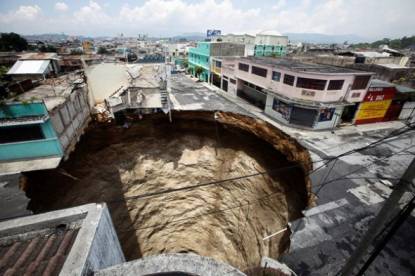
A sinkhole caused caused by tropical storm Agatha at dowtown of Guatemala City on Sunday, May 30, 2010. Torrential rains brought by the first tropical storm of the 2010. (Xinhua/Reuters Photo)
http://news.xinhuanet.com/english2010/photo/2010-06/07/c_13337833.htm
Oil extraction
Guatemala is the only proper oil-producing country in Central America. The largest oil deposits of the region are also found there. Thirty-two oil deposits are exploited in the country, which produce a total of 1.75 million tonnes of oil a year. Almost all of them are located in the nature reserve in Peten. Thousands of people belonging to indigenous nationalities live there, and they have suffered human rights abuses and pollution of their living environment.
The biggest oil company in Guatemala is Basic Oil, a subsidiary of Canadian Norce company. However, the government has granted drilling rights to five companies in 1997. At the end of the 1980's sabotage attacks damaged oil production facilities.
Mexico and Guatemala have agreed on the construction of a common gas pipeline that is being laid down from Ciudad Pemex in southern Mexico to Escuintla in northern Guatemala. It would follow the oil pipelines in the natural reserve area in Peten and would serve mainly industry and for generating electricity. This pipeline is planned to be extended to Costa Rica as part of a wider Central American gas network.
http://www.maanystavat.fi/oil/oileng/magda.htm
Mining
Marlin mine produced 274 900 ounces of gold and 4,16-million ounces of silver in 2009. The mine, in the western highlands of Guatemala, has met with sporadic opposition from some of the Mayan villages near the project since building began in 2004.
http://www.miningweekly.com/article/guatemala-to-evaluate-call-to-close-goldcorp-mine-2010-06-11
The Winter Park Sinkhole in U.S. Florida
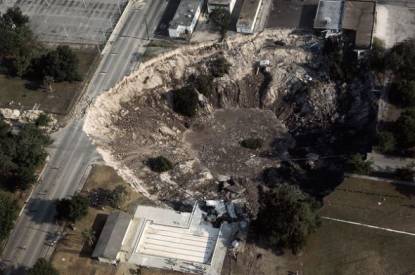
In May 1981, during a period of record-low water levels in Florida's limestone aquifer, a massive sinkhole opened up underneath the city's public swimming pool, which is near the corner of Denning Drive and Fairbanks Avenue. In a single day the hole widened to 98 meters and to a depth of 27 meters, destroying an import car dealership, a public pool, and large portions of Denning Drive. In addition, the sinkhole "ate" an entire two-story home. (Source: sina.com.cn)
http://news.xinhuanet.com/english2010/photo/2010-06/07/c_13337833_3.htm
Mulberry Sinkhole in U.S. Florida
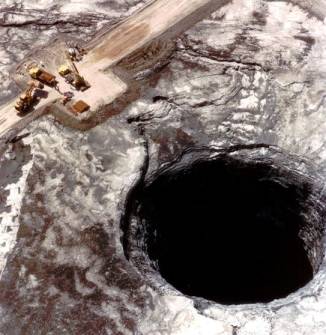
This 56-meter-deep sinkhole appeared in 1994 in Mulberry, Florida (map), in a pile of waste material dumped by mining company IMC-Agrico. (Source: sina.com.cn)
http://news.xinhuanet.com/english2010/photo/2010-06/07/c_13337833_4.htm
Oil Extraction
The Florida peninsula has produced oil since1943, though in very small quantities, from the Cretaceous Sunniland Formation at depths of 11,000 to 13,000 feet (3350 to 3960 meters). Many of these carbonate rocks would act as high quality reservoir rocks, but there are very few source rocks, and therefore, nothing to supply these reservoirs with oil. Small amounts of oil are still being produced today in a belt of porous Cretaceous limestones from west of Miami to near Fort Myers, but are marginally profitable.
The Black Warrior Basin occupies northwestern Alabama and northeastern Mississippi. The first petroleum discovery in the region was made in 1909, when natural gas was struck in rocks of Pennsylvanian age in northwestern Alabama. Most of these traps are structural in nature, and contain both oil and natural gas.
http://www.priweb.org/ed/pgws/backyard/sections/southeast/southeast2.html
Blue Hole in Belize
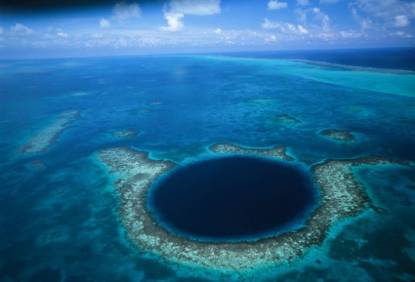
About 97 meters from Belize City, there is a perfectly circular 305 meters across and 123 meters wide deep "Blue Hole." The hole, part of the Lighthouse Reef system, was once an opening to a cave system during the Ice Age – it is now a magnet for extreme divers. (Source: sina.com.cn)
http://news.xinhuanet.com/english2010/photo/2010-06/07/c_13337833_5.htm
Petroleum and Gas Extraction
The first discovery of petroleum and gas deposits in Belize was made by Belize Natural Energy Ltd. in 2005 when the first well in Spanish Lookout began producing. Belize National Energy (BNE) has seen its production reach 5,000 barrels per day
The 18 companies with petroleum contracts are: BCH International Inc, BelGeo Ltd., Belize Natural Energy, Blue Creek Exploration Ltd., Island Oil Belize Ltd., Miles Tropical Energy Ltd., Northern Spirit Resources Inc., OPIC Resource Corporation, Perenco Limited, PetroBelize Ltd., Princess Petroleum Ltd., Providence Energy Belize Limited, RSM Production Corporation, SOL Oil Belize Ltd., Spartan Petroleum Corporation, US Capital Energy Belize Ltd., West Bay Belize Ltd., and ZMT International Inc.
http://www.belize.com/articles/oil-exploration-in-belize.html
Oklahoma
Picher Sinkhole in U.S. Oklahoma
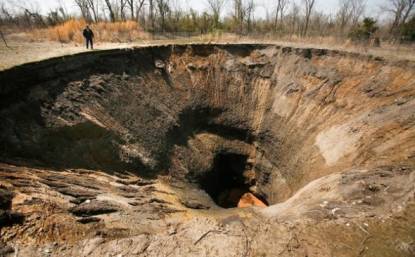
Years of mining for zinc and lead has left Picher, Oklahoma, near the border with Kansas, literally full of holes—including this sinkhole seen in 2008. (Source: sina.com.cn)
http://news.xinhuanet.com/english2010/photo/2010-06/07/c_13337833_6.htm
Oil Extraction
The first commercial paying well, the Nellie Johnstone No. 1, was drilled in 1896 near Bartlesville (Washington County). Completed in 1897 as the discovery well for the giant Bartlesville-Dewey Field, the well ushered in the oil era for Oklahoma Territory. Production there and in other areas rose rapidly thereafter, adding much impetus towards the granting of Statehood in 1907. In the 10 years between the first discovery well and Statehood, Oklahoma became the largest oil-producing entity in the world.
After the turn of the century, discoveries were made in rapid succession in areas that would eventually encompass many of the 26 major oil fields (Fig. 4). All but five of the majors were discovered before the end of World War II; the last of them, the Postle Field, was found in Texas County in 1958 Figure 2. Petroleum provinces and major Oklahoma oil fields (>100 MMBO through January 2002). Modified from Robert A. Northcutt and Jock A. Campbell (1995) and Dan T. Boyd (in press).
(Northcutt, 1985). Although the 26 majors constitute only about 1% of the total number of fields, they account for 59% of the total oil produced (Lay, 2001). Until overtaken by California in 1923, Oklahoma remained the leading producing state in the U.S. (Hinton, 2001). Peak annual production of 278 million barrels (762,000 bbls/day) was reached in 1927, with several intermediate highs and lows since then. The peaks and valleys result from changes in the number of wells drilled and completed as well as from the size of the fields being found. The historical production figures cited in Figure 5 are from the Oklahoma Corporation Commission and are based on volumes on which taxes have been paid to the State (Claxton, 2001). These volumes include condensate, but this is estimated to represent only 3% of the liquid hydrocarbons produced. Totals are believed to be accurate, but allocation of production to specific fields and reservoirs is often difficult. State records carry cumulative production by field only through 1979, forcing cumulative field-production figures to come from the International Oil Scouts Association. Also, many fields have been combined into larger fields or trends; for example, the Sooner Trend encompasses more than 100 previously defined fields.
As can be seen from well-completion history (Fig. 6), Oklahoma has had three major drilling booms. The first occurred just after Statehood; it lasted through 1930, and was most active from 1913 through 1920. That spate of drilling brought Oklahoma into the club of major oil producers. The lull that followed lasted through most of WWII, and was followed by a second boom that reached its peak in the years 1953–1956. Then drilling gradually declined, reaching postwar lows in 1971–1973.
http://www.ogs.ou.edu/fossilfuels/pdf/OKOilNotesPDF.pdf
Mining
Commercial coal mining began in Oklahoma in 1873 with the removal of bituminous coal from underground mines in eastern Oklahoma. Surface mining began in 1915. Like the oil and gas industries, the coal industry has experienced production cycles. Since 1969, the Oklahoma coal industry has had as few as eight active mines and as many as sixty. Oklahoma coal production has declined from its peak of 5.73 million tons in 1981, to a low of 1.4 million tons in 2002. The Oklahoma Department of Mines recorded approximately 1.4 million tons of bituminous coal produced from 11 mines in seven counties for the year 2006. Until recent years, the major consumption of Oklahoma coal had been by out-of-state utilities. Major in-state use of Oklahoma coal has been by the cement and lime industry, and utilities.
China
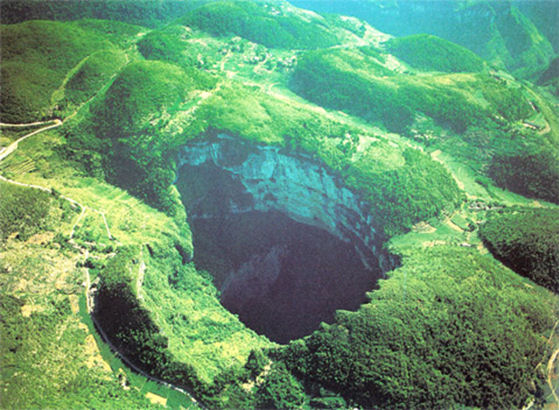
Beginning 2010 April 27, several sinkholes appeared one after another in Yinbin City of Sichuan province, with the number of sinkholes numbering over a dozen. The local land department has stated that the “sinkholes” were caused by coal mining, and through investigation has confirmed that there is no impact upon villagers
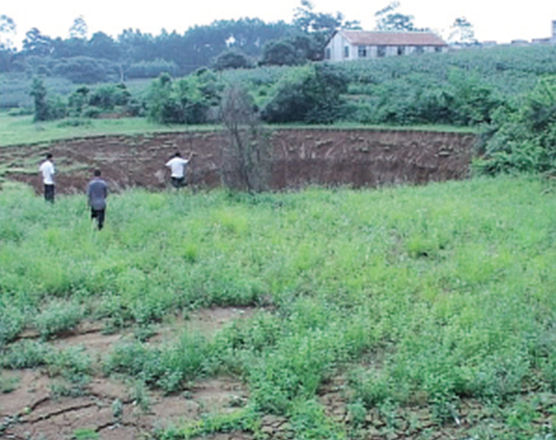
2009 June 13, a dried up fish pond in Yiling Village of Shuangqiao Town of Wuming County of Guangxi Province suddenly collapsed, becoming an 80 meter wide, 20 meter deep circular pit. There are also many cracks around the sinkhole, with the cracks growing in size.
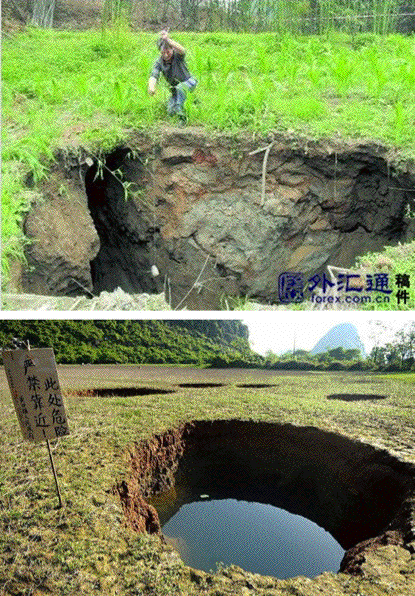
Oil Extraction
Chinanews, Tianjin, Aug.12 (By Liu Junwu) - At present, China's oil consumption largely depends on imports. Statistics show that last year, China imported 120 million tons of crude oil in total. It is estimated that if China maintains an economic growth of 7% more or less in the coming 15 years, its crude oil demand will grow at least 4% and the gap between crude oil supply and demand will broaden year after year. On the other hand, owing to continuous hiking international crude oil price and the weakening greenbacks, China's import price of crude oil will still be going up on the whole.
Under such circumstance, expansion of offshore oil exploitation has become one of China's new oil development strategies. China reportedly plans to increase its exploitation scale to twice that of 2003 by 2010. China's crude oil output in 2003 was 169 million tons while its offshore oil output was only 33 million tons. Experts predicted that in the future, growth of oil output will be more and more reliant on offshore exploitation and China's oil exploration is entering a phase of rapid development.
http://houston.china-consulate.org/eng/nv/t207070.htm
Mining
Mineral Resources
With complicated geological structures and favorable conditions for mineralizing, Sichuan boasts abundant and a comparatively full range of mineral resources. 132 varieties of mineral resources have been discovered, accounting for 70% of the national total. 94 varieties have been verified of considerable reserves, 32 among which rank the top 5 in China in terms of ensured reserves. Of all the mineral resources, reserves of 7 minerals including titanium, vanadium and pyrites rank the first in China. Reserves of titanium and vanadium in Sichuan are of global significance and the reserves of the former and the later respectively account for 82% and 1/3 of the global total reserves. Moreover, Sichuan’s reserves of 11 minerals like natural gas, lithium and mirabilite rank the second in China; reserves of another 5 like platinum-group metals and iron rank the third in China; reserves of 8 minerals including dolomite used for smelting magnesium and light rare-earth rank the fourth and reserves of phosphate rank the fifth in the country.
http://english.sc.gov.cn/SichuaninPerspective/BriefingaboutSichuan/200906/t20090624_770715.shtml
Uranium Mining
China is estimated to mine 1,200 tons of uranium annually and is expected to stay at this level of production for the near future. China's first eight uranium mines were fully operational beginning in 1962-1965. Over the years, China has established a total of about 26 major uranium mines. Since the beginning of the opening and reform process, China's uranium mining industry has undergone extensive reorganization. China has reduced output and closed inefficient mines resulting in a reduction of personnel from 45,000 in 1984 to 8,500 in 1999. As part of its efforts to improve efficiency, China is focusing on in-situ and heap leach technologies. Improvements in management and technology have led to uranium mining facilities becoming three to four times more efficient.
China has traditionally located uranium processing facilities at or near uranium mines. China's "backbone" of uranium mining and metallurgy has traditionally been located in Guangdong, Jiangxi, and Hunan Provinces. However, in recent years uranium exploration has been focused on northwest and north China. There is potential for expanding the uranium mining facility at Yili Basin, Xinjiang where in-situ leach capacity is expected to reach approximately 400 tU/year. New production centers have been opened at the the Yining in-situ leaching facility, the Lantian heap leaching facility and the Benxi mine.
URANIUM MINES
NAME |
LOCATION |
COMMENTS |
Anshun |
Guizhou Province |
|
Baimadong |
Guizhou Province |
Closed uranium mining and ore processing facility; 40 tons per year capacity; start up: 1965; closed: 1989 |
Benxi |
|
Plans to use "trackless mining" and heap leaching following acid curing. |
Chanziping |
Guangxi Province |
|
Chenxian |
Hunan Province |
China's first uranium mine; Soviet-designed; partially operational in September 1960; began full production in September 1962; uses shrinkage stopping mining technique; Soviet-designed and equipped magnetic separator facility was built near the mine |
Chenzhou |
Hunan Province |
|
Chongyi |
|
|
Daladi |
Xinjiang Province |
|
Dapu |
Hengshan County, Hunan Province |
One of China's first uranium mines; Soviet-designed |
Dianxi |
Yunnan Province |
|
Dongkeng |
Hunan/Jiangxi Provinces |
|
Fuzhou |
Fuzhou (Hengjian), Jiangxi Province |
One of China's two significant mining and metallurgical sites; also the site of the Hengjian uranium ore processing facility; used radiometric sorting starting in the 1980s |
Guidong |
Guangdong Province |
|
Hengshan |
Hunan Province |
|
Hengyang |
Hunan Province |
Uranium mining and ore processing facility |
Jianchang |
Liaoning Province |
|
Kaiyang |
Guizhou Province |
|
Kashi |
Xinjiang Province |
|
Lanhe |
Hunan/Jiangxi Provinces |
|
Lantian |
Shaanxi Province |
One of China's main uranium production centers; estimated capacity of 100 tons of U per year, but currently operating at about 30 tons per year; uses heap leaching |
Lianxian |
Lianxian, Guangdong Province |
Opened in 1963 |
Linxian |
Linxian, Hunan Province |
Began trial extraction in April 1962 |
Menqikuer |
Xinjiang Province |
|
Quzhou |
Zhejiang Province |
Has used "trackless mining" since the 1980s |
Renhua |
|
Plans to use "trackless mining" |
Shangrao |
Shangrao, Jiangxi Province |
Soviet-designed; also location of hydrometallurgical plant for uranium extraction similar to the plant at Hengyang |
Tenchong |
|
|
Xiangshan |
Zhejiang Province |
|
Xunwu |
Jiangxi Province |
|
Yili Basin |
Xinjiang |
Uranium reserve base |
Yining |
Xinjiang Province |
In-situ leaching facility; closed uranium mining and ore processing facility |
Zolge |
Sichuan Province |
|
http://www.nti.org/db/china/umines.htm
Mining and Quarrying
Mineral deposits are abundant and varied. They include metallic and non-metallic deposits, such as those of iron, copper, gold, silver, aluminum, salt, coal, petroleum, asbestos, and marble. Sichuan is also the only major producer of brine salt in China.
http://202.84.17.11/english/china_abc/sichuan.htm
Conclusion
Each country listed above has been involved in oil extraction or mining and in some cases both oil extraction and mining. It seems logical to say that the results of extracting oil and mining are becoming more noticeable and more serious. In Contact Report 45, Semjase tell us that “slowly the Earth collapses from within”. Are we now seeing this starting to happen in countries that exploit the Earth beneath them? My answer to this question is yes. Clearly, the Earth has to collapse from within to create the sinkholes. What does the future hole regarding all this? I will leave it up to you, the reader, to think, and possibly do something, about it - if anything is indeed now possible to change because of what humans have set in motion by their exploitation of the Earth.
Prepared by Stephen Moore - 22/06/2010
Posted by: Michael Horn
6.22.10